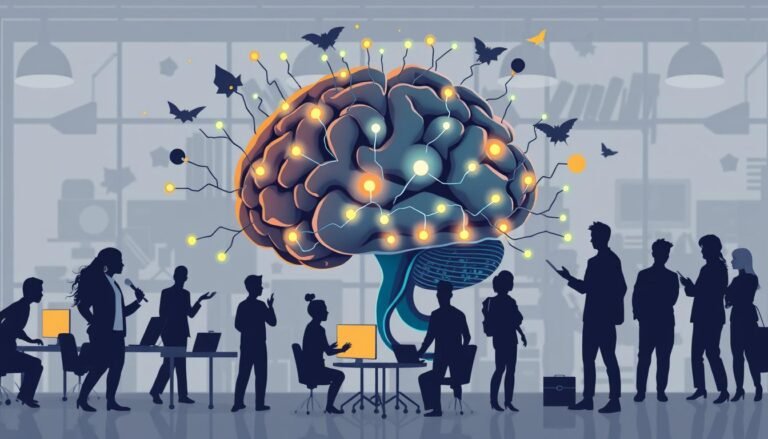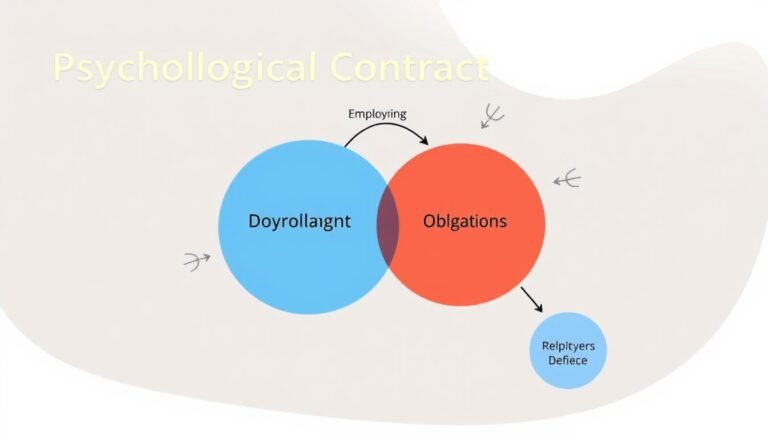Psychological Burnout Mechanisms
Burnout is a big problem for many workers today. It comes from long-term stress and feeling emotionally drained. This can really hurt your mental health and how well you do at work.
Studies say burnout hits 7-9% of workers in Europe. In fields like medicine, up to 50% of professionals face burnout symptoms. These numbers show we need to understand what causes burnout.
Work pressure is a big part of burnout. Research on IT firms shows a strong link between stress at work and burnout. How well you fit your job and company culture also matters. Not fitting well can increase your risk of burnout.
Faking emotions at work, called surface acting, is another factor. It takes a toll on your emotional energy and job performance. Burnout can make you feel tense, irritable, and affect your sleep. It can even change your body’s stress hormone levels.
Key Takeaways
- Burnout affects 7-9% of European workers
- Up to 50% of doctors show clinical burnout signs
- High work pressure strongly links to job burnout
- Poor job and company fit increase burnout risk
- Surface acting at work can lead to emotional exhaustion
- Burnout causes sleep issues and hormone changes
Understanding the Core Components of Burnout Syndrome
Burnout syndrome is a complex condition affecting millions globally. In Germany, 2.7 million workers face it. It’s made up of three main parts that create a stressful work environment.
Emotional Exhaustion and Mental Fatigue
Emotional exhaustion is the first sign of burnout. It’s like a drained battery. Workers feel tired and lack energy for work.
A UK survey showed 30% of HR directors see burnout in their teams. This shows how common it is.
Depersonalization and Cynicism Development
Depersonalization is the second part of burnout. It makes people see work and others as objects, not people. This cynicism is a way to cope with exhaustion.
Reduced Personal Accomplishment Impact
The last part is feeling like you’re not accomplishing anything. Workers feel their efforts are pointless. This can lower job satisfaction and performance.
Studies, like the Maslach Burnout Inventory, have helped understand burnout. Other tools also measure these burnout parts, giving us important insights.
The Science Behind Psychological Burnout Mechanisms
Psychological burnout is a complex issue linked to our brain’s stress response. Recent studies have uncovered the neurological processes behind burnout. They reveal how it affects our thinking and overall health.
Neurological Response to Chronic Stress
Chronic stress is a key factor in burnout. Studies show that burnout leads to heightened physical tension and irritability. A 2022 study by Montgomery found that burnout worsens performance in tasks that need planning and coordination.
HPA Axis Dysregulation
The HPA axis is vital for our stress response. In burnout, this system gets out of balance, causing abnormal cortisol levels. This imbalance can lead to sleep problems and other physical symptoms of burnout.
Cognitive Function Changes
Burnout has a big impact on our thinking abilities. A 2023 study by Hartikainen showed that burnout slows down switching between different mental tasks. Another study by Sokka in 2016 found that severe burnout harms working memory and increases brain activity, showing a higher need for mental effort.
| Cognitive Function | Impact of Burnout |
|---|---|
| Executive Functions | Decreased performance in planning and task coordination |
| Working Memory | Reduced responses in posterior brain regions |
| Cognitive Flexibility | Slower transitions between cognitive processes |
These studies highlight the need to treat burnout seriously, as it affects brain function. It’s crucial for both organizations and individuals to focus on preventing and addressing burnout. This will help keep our brains healthy and our overall well-being intact.
Workplace Factors Contributing to Burnout
Job burnout is on the rise, especially among healthcare workers due to the pandemic. Work overload is a major cause, leading to serious health problems. When employees face too much work without enough resources, they risk burning out.
Lack of control at work can demotivate employees. Feeling powerless in one’s role increases burnout risk. Feeling unappreciated or unrewarded also adds to job dissatisfaction.
Poor workplace relationships contribute to burnout. Discrimination and unfair treatment raise burnout chances. On the other hand, having work friends can help manage stress, showing the value of positive work connections.
When personal and work values don’t match, job satisfaction drops. This mismatch makes employees feel out of place, making them more prone to burnout. Healthcare and teaching are among the most burnout-prone jobs, due to their high-stress nature.
“High workload, value incongruence, low control over the job, low decision latitude, poor social climate/social support, and low rewards are key factors contributing to burnout in nursing.”
These workplace issues harm not just individual well-being but also the organization’s success. Burnout can cause lower job performance, poor care quality, and a desire to leave. This creates a cycle of stress and dissatisfaction in the workplace.
Individual Risk Factors and Personality Traits
Personality traits are key in determining burnout risk. Research with 3,320 papers has uncovered important insights. It shows how personality affects the likelihood of burnout.
Type A Personality Correlation
Type A personalities are driven by ambition and competition. They often face higher burnout rates. This is because they push themselves too hard, leading to stress and exhaustion.
Neuroticism and Burnout Susceptibility
Neuroticism is strongly linked to burnout. Those with higher neuroticism scores are more likely to feel emotionally drained and disconnected. This trait, marked by anxiety and emotional sensitivity, can increase work stress.
Personal Resilience Factors
Personal resilience can protect against burnout. Gerber et al. (2014) studied 460 police officers. They found that those with a hardy personality managed stress better and had better health outcomes.
| Personality Trait | Correlation with Burnout (r) | Impact on Burnout Risk |
|---|---|---|
| Neuroticism | 0.10 to 0.642 | Increased risk |
| Agreeableness | -0.12 to -0.353 | Decreased risk |
| Conscientiousness | -0.12 to -0.355 | Decreased risk |
| Extraversion | -0.034 to -0.33 | Decreased risk |
| Openness | -0.18 to -0.237 | Decreased risk |
Surface Acting and Emotional Labor Impact
Emotional labor is big in the workplace, especially in service jobs. A study with 286 hotel and catering workers showed how surface acting and deep acting affect work engagement.
Resource Depletion Theory
Surface acting means faking emotions. It drains a lot of energy, leading to exhaustion. The study found that surface acting made workers more likely to pull away from their jobs.
Work Engagement Effects
Deep acting, on the other hand, didn’t make workers want to pull away. When employees really felt the emotions they were supposed to, they stayed engaged. Emotional exhaustion was the link between acting and wanting to pull away.
| Acting Type | Effect on Withdrawal Behavior | Impact on Work Engagement |
|---|---|---|
| Surface Acting | Positive | Decreased |
| Deep Acting | Negative | Increased |
But, mindfulness played a role. It helped lessen the negative effects of emotional labor on staying engaged at work.
Sleep Disruption and Burnout Cycle
Sleep problems are key in the burnout cycle. About 50% of doctors face burnout, harming their health. This burnout includes feeling emotionally drained, losing touch with others, and feeling less accomplished.
Not sleeping for over 24 hours can mess with your thinking. Going without good sleep for 6 nights or more hurts your brain and causes stress. This fatigue makes it tough to deal with work demands.
The effect of sleep issues on burnout is big:
- 80% of medical residents show physical signs from not sleeping enough
- Poor sleep can lead to pregnancy problems and car crashes
- Doctors who don’t sleep well might feel depressed and use drugs more
- Not enough sleep means losing good workers and more medical mistakes
The link between sleep and burnout is a cycle. Burnout causes sleep problems, and sleep issues make burnout worse. This cycle drains your energy and makes it hard to handle stress, making burnout worse.
“Sleep is the golden chain that ties health and our bodies together.” – Thomas Dekker
It’s important to break this cycle to avoid and manage burnout. Getting enough quality sleep can boost your energy and well-being. This makes it easier to deal with work stress and prevent burnout.
Person-Environment Fit in Burnout Development
The way a person fits into their work environment is key to avoiding burnout. This idea, called person-environment fit, includes how well a person fits their job, their organization, and their work-life balance.
Job-Person Alignment
Person-job fit means how well a person’s skills match the job’s needs. A study with 568 people showed that feeling able to do the job well lowers depression and anxiety. This means if employees can handle their job, they’re less likely to burn out.
Organizational Culture Impact
How well a person fits with their organization affects their job happiness and loyalty. The same study found that feeling like you fit with your company lowers depression and anxiety. This shows it’s vital to match your personal values with your company’s culture to avoid burnout.
Work-Life Balance Factors
Work-life balance is crucial in stopping burnout. The study found that feeling like work and personal life are in balance reduces depression and anxiety. This means when work and personal life are in sync, people can handle stress better and avoid burnout.
| Fit Type | Impact on Depression | Impact on Anxiety |
|---|---|---|
| Person-Organization Fit | Lower scores | Reduced symptoms |
| Demands-Abilities Fit | Lower severity | Lower severity |
| Needs-Supplies Fit | Less symptom severity | Less symptom severity |
These results show how important person-environment fit is in stopping burnout. By focusing on job fit, company culture, and work-life balance, both workers and employers can make a better work place.
Physical and Mental Health Consequences
Burnout severely affects both physical and mental health. It can lead to serious health problems. These include issues with the heart, brain function, and mental stability.
Cardiovascular Impact
Long-term burnout raises the risk of heart problems. Research shows it can cause high cholesterol, diabetes, and heart disease. The body’s stress system gets overworked, leading to high blood pressure and heart rhythm issues.
Cognitive Function Deterioration
Burnout can harm brain function. It affects memory, focus, and decision-making. People find it hard to concentrate and remember things. This damage can last long after the stress is gone.
Mental Health Complications
Burnout has a big impact on mental health. It can cause sleep problems, depression, and anxiety. Many turn to medication to cope with these issues, showing how serious the mental health effects are.
| Health Consequence | Prevalence | Impact |
|---|---|---|
| Cardiovascular Issues | High | Increased risk of heart disease, hypertension |
| Cognitive Decline | Moderate | Impaired memory, concentration difficulties |
| Mental Health Problems | Very High | Depression, anxiety, insomnia |
It’s important to recognize these health issues early. By tackling the causes and using stress management, we can avoid burnout’s harm. This helps keep our bodies and minds healthy.
Conclusion
Burnout prevention is a big challenge in many jobs. Almost all jobs face burnout, affecting employees, their families, and companies. It can lead to health problems like heart issues and mental health issues like depression.
Building mental strength is important to fight burnout. Studies show that mindfulness programs can cut down stress and emotional burnout. For example, social workers in a mindfulness program felt much better.
Managing stress well is vital, given the high rates of burnout. In the UK, 60% of social workers want to leave because of stress. Social workers’ careers are very short, lasting less than 8 years. These facts highlight the need for better burnout prevention in all fields.
To tackle burnout, we need a wide range of solutions. We must improve work conditions, support work-life balance, and build supportive work cultures. By focusing on these, we can make workplaces and people healthier and more resilient.
Source Links
- Frontiers | A study of the psychological mechanisms of job burnout: implications of person–job fit and person–organization fit
- Burnout phenomenon: neurophysiological factors, clinical features, and aspects of management
- Burnout: A Review of Theory and Measurement
- Understanding the burnout experience: recent research and its implications for psychiatry
- Burnout and the Brain
- Burnout Exhausts Brain Function and Physiology
- Burnout Comes in Three Varieties
- Frontiers | The Relationship Between Burnout, Depression, and Anxiety: A Systematic Review and Meta-Analysis
- Six Causes of Burnout at Work
- Burnout in nursing: a theoretical review – Human Resources for Health
- Big five model personality traits and job burnout: a systematic literature review
- Frontiers | Psychosocial Risk Factors, Burnout and Hardy Personality as Variables Associated With Mental Health in Police Officers
- The hidden costs of emotional labor on withdrawal behavior: the mediating role of emotional exhaustion, and the moderating effect of mindfulness – BMC Psychology
- Emotional Labor and Burnout: A Review of the Literature
- Exploring the Relationship between Surface Acting, Job Stress, and Emotional Exhaustion in Health Professionals: The Moderating Role of LMX
- Sleep Deprivation, Burnout, and Acute Care Surgery
- Sleep and biological parameters in professional burnout: A psychophysiological characterization
- Associations between person-environment fit and mental health – results from the population-based LIFE-Adult-Study
- Associations between person-environment fit and mental health – results from the population-based LIFE-Adult-Study – BMC Public Health
- Physical, psychological and occupational consequences of job burnout: A systematic review of prospective studies
- Burnout: Symptoms, Treatment, and Coping Strategy Tips
- Physical, psychological and occupational consequences of job burnout: A systematic review of prospective studies
- Frontiers | The psychological mechanism of basic psychological need frustration affecting job burnout: a qualitative study from China
- Testing Mindfulness Mechanisms of Action on the Stress and Burnout of Social Workers – Mindfulness








